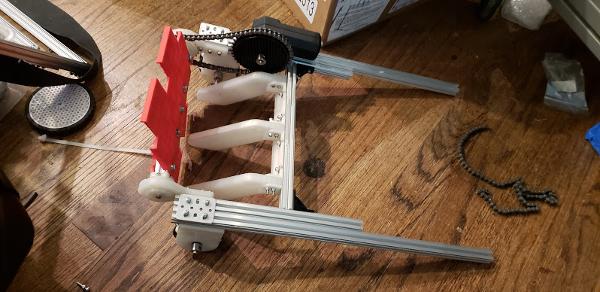BigWheel Arm
Tags: design, think, innovate, and buildPersonhours: 4
Task: Design an arm for BigWheel

Bigwheel’s intake arm is one of the most important parts of the robot. Since our scrimmage, we have learned how to make this arm much more efficient, starting with some supports. The original intake arm was made of two scrap Tetrix rails. The result of this was that the two sides of the arm would be out of sync, creating a twist in the arm that caused it to move oddly. Thus, it has been stabilized with cross beam REV rails.
The next upgrade on the arm is going to be the box to hold the minerals. Right now it’s just a cardboard prototype and we need to move to the next version. After a bit of debate, we decided to craft it out of polycarb. The reason polycarb was not our immediate solution is because it’s unfortunately quite heavy, and instead the first thing we came to think of was thin plywood and duct tape. Thin slices of plywood would be taped together to create a fabric like box that still had form. This idea still lent itself to breakage, and we next went to a design using a thin plastic sheet, the same kind of plastic that is used inside milk cartons. The only issue is that it’s super weak and doesn’t form well, so we would have to build a frame for it, much like the plywood and tape.
Next Steps
Right now we’re toying around with the idea of an arm that not only flips out but also extends using a gear and tooth track made from Tetrix parts of days gone by. The reason for this is to gain a little extra height that we were lacking before in the robot and a little more flexibility when we grab minerals from the crater. To do this I had to take apart the arm from our first ever FTC robot, and use the toothed track and gear plus the extra long tetrix bars to create the slides. So far the slides are surprisingly smooth and we have high hopes for the future of the arm.
